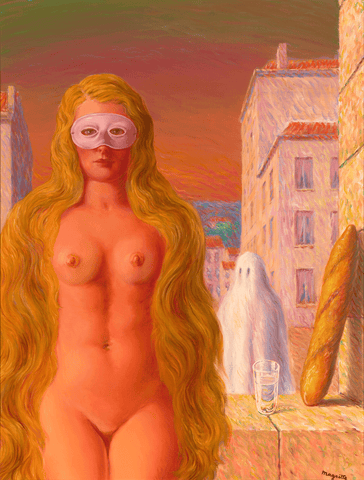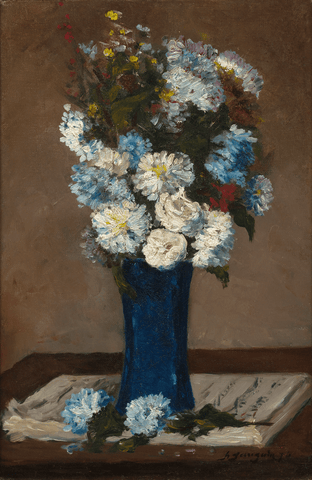Without a doubt one of the most influential men of the 20th century, Sir Winston Leonard Spencer Churchill (1874-1965) is a name that will be echoed for centuries to come. As a man who is considered one of the most important statesmen of the 20th century, both his accomplishments and fame are far-reaching.
Not only was he a pivotal figure in the United Kingdom during World War II, recent attention has turned to a lesser-known aspect of Churchill’s career— he was also a prolific painter. Churchill did not paint to boast of his success, but rather to ease his mind while upholding his significant responsibilities.
Sir Winston Churchill was born on November 30th, 1874 at Blenheim Palace, Oxfordshire, England. His father, Lord Randolph Churchill, was an English aristocrat and a direct descendant of the First Duke of Marlborough. Churchill’s mother, Jenny Jerome, was the daughter of Leonard Jerome, a wealthy American businessman and financier. Throughout the Churchill and his brother Jacks' lives, their mother and father were effectively estranged and most of their upbringing was orchestrated by their nanny, Elizabeth Everest.
At age seven, Winston was sent to St. George’s School in Ascot, Berkshire. Because he failed to take his academic seriously, he was transferred to Brunswick School in Hove, East Sussex. His academic prowess improved and in April 1888, at age 13, he was narrowly accepted into Harrow School in London. Churchill’s father dreamed of his son having a military career, and tried to get Winston into the prestigious Royal Military Academy in Sandhurst. Unsurprisingly, Churchill was rejected twice only to be accepted on his third attempt. Churchill was placed into a cadet role in the cavalry and began his studies and training in September of 1893. Churchill’s father died on the 24th of January, 1895, a month after Churchill graduated.
In February 1895, Churchill began his military service as a second lieutenant in the 4th Queen’s Own Hussars. Churchill was first sent to Cuba, where he observed and participated in the war of independence. After his time in Cuba, he traveled to New York, where he wrote to his mother about his first real experience with American soldiers. According to Churchill, the Americans were “extraordinary people,” a sentiment that likely warmed his American mother’s heart. His next mission was in India and Churchill stayed in Bombay (Mumbai) for 19 months. Churchill also traveled to Calcutta three times and made expeditions to the North Western Frontier. As a man of many interests, Churchill spent his free time in India voraciously reading classical works from Plato, Charles Darwin, Edward Gibbon, and Thomas Macauly.
After his first visit to India, Churchill returned to England and became involved with political and parliamentary affairs. His time in England did not last long, however, and Churchill quickly returned to India to join the army in a campaign against the Mohmand rebels in Swat Valley (the North Western part of the Sub Continent). During this campaign, Churchill began writing his first book, “The Story of the Malakand Field Force.” After a subsequent campaign in Sudan, Churchill made the decision to leave the army, a choice most likely influenced by General Kitchener’s cruel treatment of wounded enemy soldiers in the city of Omdurman. This was the start of his famed political career.
In June 1899, Churchill was a candidate in the parliamentary election of Oldham, Lancashire, an election he narrowly lost. He then sailed to South Africa, where he served as a journalist. While in South Africa he was captured by the Boers, and he subsequently escaped the camp to Portuguese East Africa. Despite the harrowing nature of Churchill’s journalism career and escape, he needed more excitement and thus reenlisted in the army to fight the Boers.
After his time both documenting and fighting in the South African campaign, Churchill re-entered England’s political sphere. From 1901 to 1904 he served as a conservative MP, and from 1904-1908 he served as a Liberal MP. This important switch was due to his rejection of the conservative Anti-Jewish migration; he openly opposed prejudice against Jews. From 1908-1910 he was President of the Board of Trade, and from 1910-1911 he was the Home Secretary. His most infamous service was during his time as First Lord of the Admiralty, beginning with honor in 1911 and ending in disgrace in 1915.
April 25th, 1915 was the beginning of a disaster. The Gallipoli campaign during World War I would become a great stain Churchill could never remove. As the First Lord of the Admiralty, he was responsible for the entire failed operation and the aftermath lead him to sink into a deep depression. Churchill’s beloved wife Clementine believed he would die from his grief. Later in 1915, Churchill began observing his sister-in-law, an amateur painter, and became interested in the hobby. This hobby turned into a life-long commitment— a hobby that brought Churchill back to life.
Churchill loved to paint bright and cheerful scenes, a fitting contrast to his combat and depression. Some of his favorite scenes to paint were still-lifes of flowers, fruits, houses and nature. One of his more notable works was The Moat, Breccles, highlighting the serene landscape of the United Kingdom. After 40 years in his personal collection, he eventually gifted this oil painting to Greek shipping magnate and good friend, Aristotle Onassis. Churchill looked to J.M.W Turner, Paul Cezanne, and Henri Matisse with admiration, and received lessons from Sir John Lavery, Walter Sickert, and Sir William Nicholson.
Shortly after Churchill became the Secretary of State for the Colonies in February of 1921, his paintings were featured in his first public exhibition at the Galerie Druet. To accompany this public display, Churchill wrote two articles for the Strand Magazine, “Hobbies” and “Painting as a Pastime,” in which he expressed his love and enjoyment of painting. Churchill began painting even more in 1922 when he underwent appendix surgery and was voted out of the seat of Dundee. Churchill spent his recovery painting and writing at the
Villa Reve d'Or in Cannes, France. During this time, Churchill's paintings exhibit his personal reflections and experiences. For instance, his work Koutoubia Mosque captures the essence of North Africa, a region significant in his military career, especially during the Second World War.
In 1947, Churchill began showing his artwork at the Royal Academy of Arts’ Summer Exhibition; he did so every year after until 1964. In 1948, the Academy elected Churchill as an “Honorary Academician Extraordinary,” a title upon which no previous or succeeding amateur artist had been bestowed. In the same year, his book “Painting as a Pastime” was published, based on his aforementioned Strand Magazine essays. “If it weren't for painting, I couldn't live. I couldn't bear the strain of things,” Churchill once said to Sir John Rothenstein. Dr. Charles Wilson, First Baron of Moran, told of Churchill, “He sees everything in pictures.”
Throughout his lifetime, Churchill created over 500 paintings. In 1967, his first catalogue raisonné
was published by art historian David Coombs. In 1998, Sotheby's in London exhibited 105 Churchill paintings and over 12,000 people visited them in just two weeks. His paintings have been displayed in the most prestigious museums throughout Europe, Asia, North America and Australia. These are achievements that no other amateur artist can claim.
Sir Winston Churchill’s legacy is monumental. He led his nation through bombs and blood; his unshakable spirit and never-quit attitude were quintessential in the Allied Victory. His artistic legacy amplifies art’s power in its ability to save the human spirit.
Original paintings by Sir Winston Churchill remain highly coveted by art collectors worldwide. M.S. Rau proudly offers a curated selection of these original works. For more information, please contact us today.









